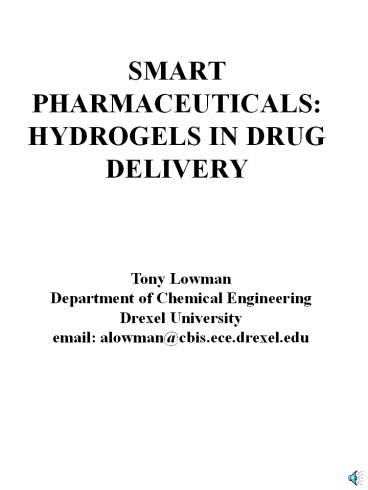SMART PHARMACEUTICALS: HYDROGELS IN DRUG DELIVERY - PowerPoint PPT Presentation
Title:
SMART PHARMACEUTICALS: HYDROGELS IN DRUG DELIVERY
Description:
SMART PHARMACEUTICALS: HYDROGELS IN DRUG DELIVERY – PowerPoint PPT presentation
Number of Views:3171
Avg rating:3.0/5.0
Title: SMART PHARMACEUTICALS: HYDROGELS IN DRUG DELIVERY
1
SMART PHARMACEUTICALSHYDROGELS IN DRUG DELIVERY
Tony Lowman Department of Chemical
Engineering Drexel University email
alowman_at_cbis.ece.drexel.edu
2
GOALS OF CONTROLELD RELEASE SYSTEMS
Profile of conventional drug delivery system
DOSE 1
DOSE 2
Toxicity
DRUG PLASMA LEVEL
Therapeutic
TIME
- LIMITATIONS
- Multiple administrations necessary to maintain
drug in - therapeutic amounts in the blood stream
- Plasma concentration may exceed the toxicity
level - Side effects could be severe
- Increased cost of pharmaceutics
3
GOALS OF CONTROLELD RELEASE SYSTEMS
Profile of ideal controlled release system
- Maximize therapeutic efficacy of drug
- Reduced costs due to optimal administration
- Reduction in side effects
4
Hydrogels
- Hydrophilic, insoluble polymer structures
- Insoluble due to chemical or physical crosslinks
- Imbibe large amounts of water (or physiological
fluids) - Highly biocompatible!!!!
Drug delivery Tissue engineering scaffolds Wound
healing devices Vascular grafts Orthopedic
implants.
5
Hydrogels
- Numerous classifications
- Wide range of properties
- Numerous applications in drug delivery
6
Structural Parameters
? , Mc
rh
7
Classifications
- 1. Nature of gel
- Neutral
- Ionic
- Responsive
8
Classifications
- 2. Types of polymers
- homopolymers
- Copolymers
- Interpenetrating networks
- Physical structure
- amorphous
- semi-crystalline
- H-bonded structures
- colloidal aggregates
9
Classifications
- Morphological
- Non-porous 10-100 Å
- Microporous 100-1000 Å
- Macroporous 0.1-10 mm
10
Classifications
- Release mechanism
- Diffusion controlled release system
- Swelling controlled release systems
- (BIO) erodible/degradable systems
- Pendant chain systems
- Responsive systems
- SIGNIFICANT OVERLAP EXIST!!!!
11
Diffusion Controlled Release Systems
Reservoir system
Matrix system
12
Diffusion in Polymer Networks
? , Me
rh
13
Diffusion Controlled Release Systems
(1)
(2)
Short time approximation (80 release)
(3)
14
Swelling Controlled Release Systems
W, water G, swollen gel D, drug P, glassy
polymer u, front velocity
15
Diffusion vs. SwellingControlled?
(1)
(2)
16
(BIO?)Degradable/Erodible Systems
Can use stimulus to degrade/erode/dissolve
polymer
17
Pendant Chain Systems
18
Responsive systems
19
Responsive systemspH-responsive
UPPER SMALL INTESTINE
STOMACH
pH increase
20
Experimental Techniques
21
Network Structural Analysis
(1)
(2)
22
Determination of Drug Diffusion Coefficients
Membrane permeability experiments Ficks 1st
Law
(1)
(2)
(3)
(4)
23
Experimental Determination of Drug Diffusion
Coefficients
Membrane permeability experiments
Permeability of vitamin B12 through PEG
hydrogels.
24
Experimental Determination of Drug Diffusion
Coefficients
Release experiments Geometric constraints
25
Experimental Determination of Drug Diffusion
Coefficients
Dissolution experiments
k 4D1/2/(? 1/2 ?)
Release of vitamin B12 from PEG hydrogels.
26
For more information
- A.M. Lowman and N.A. Peppas, "Hydrogels" in E.
Mathiowitz, ed., Encyclopedia of Controlled Drug
Delivery, Wiley, New York, 1999, pp. 397-418. - N. Peppas, Hydrogels in Medicine and Pharmacy,
CRS Press, Boca Raton, 1986.

